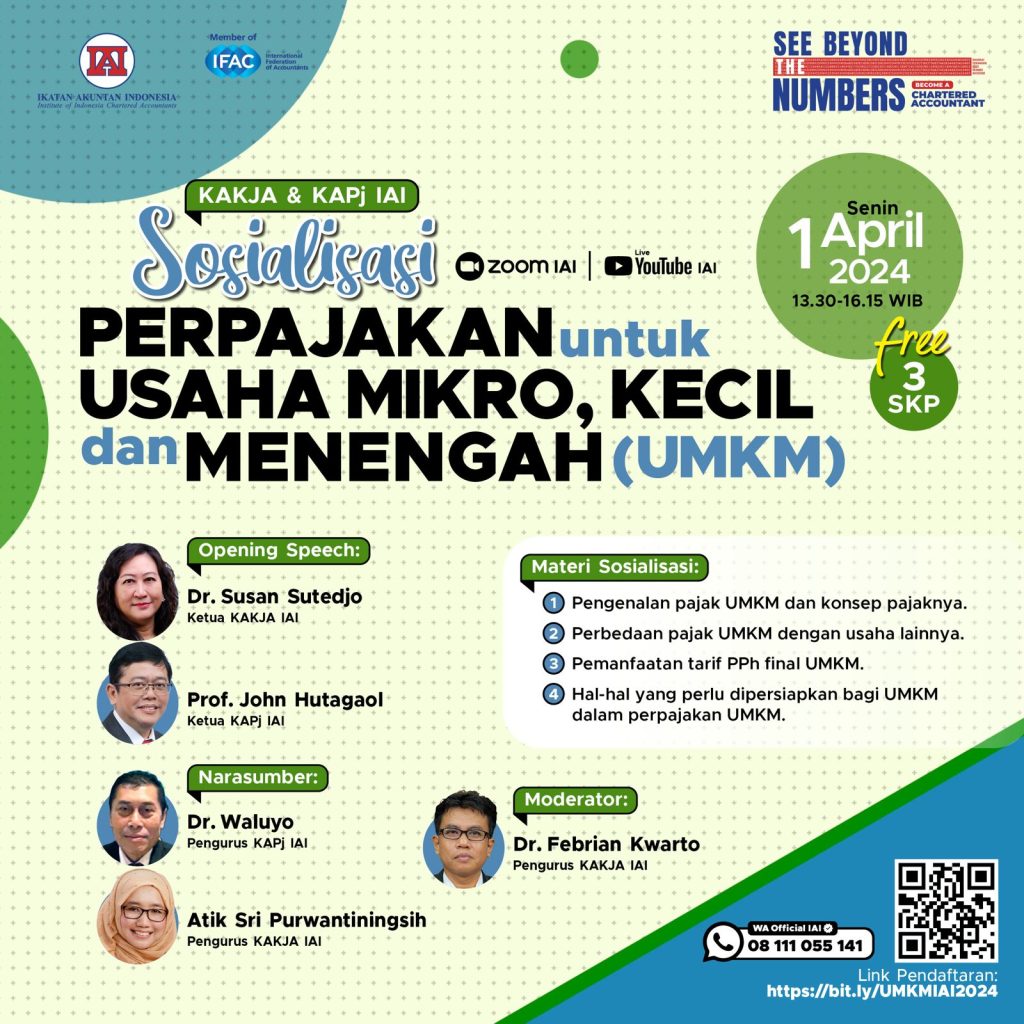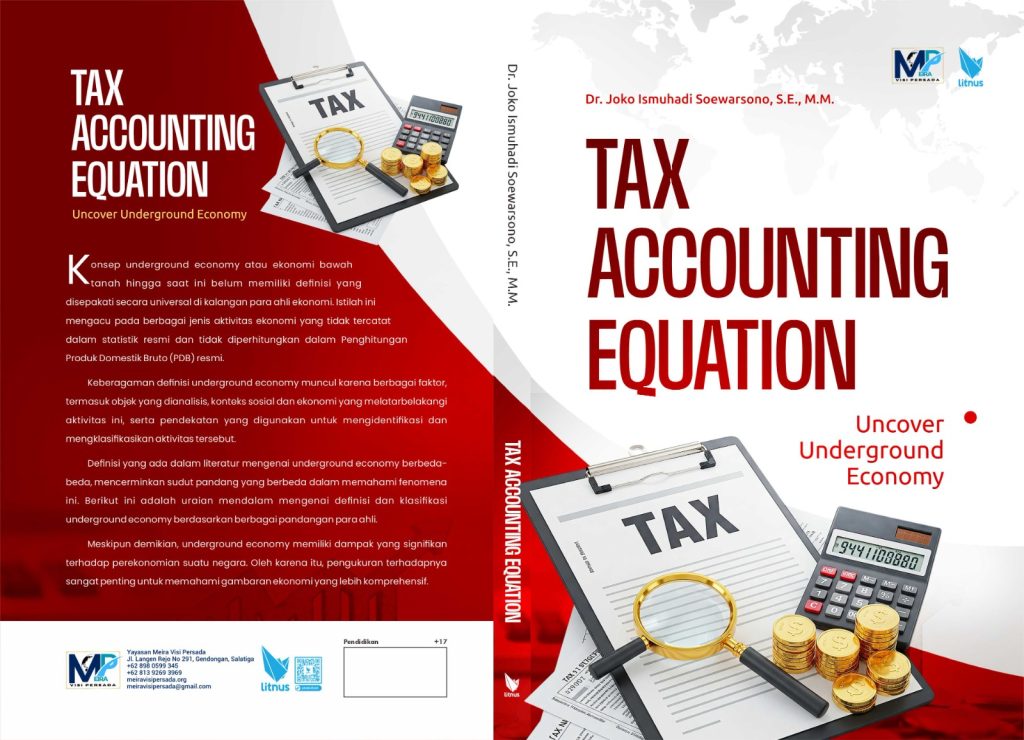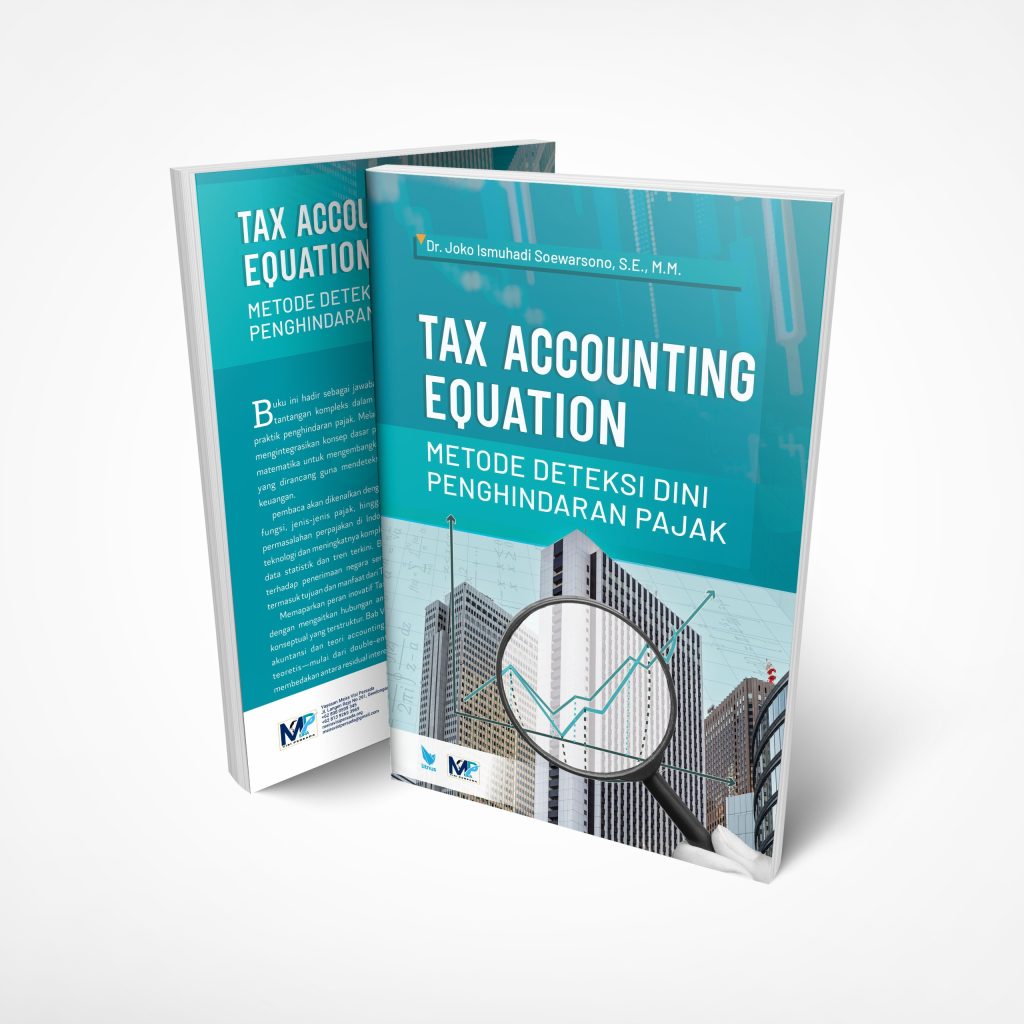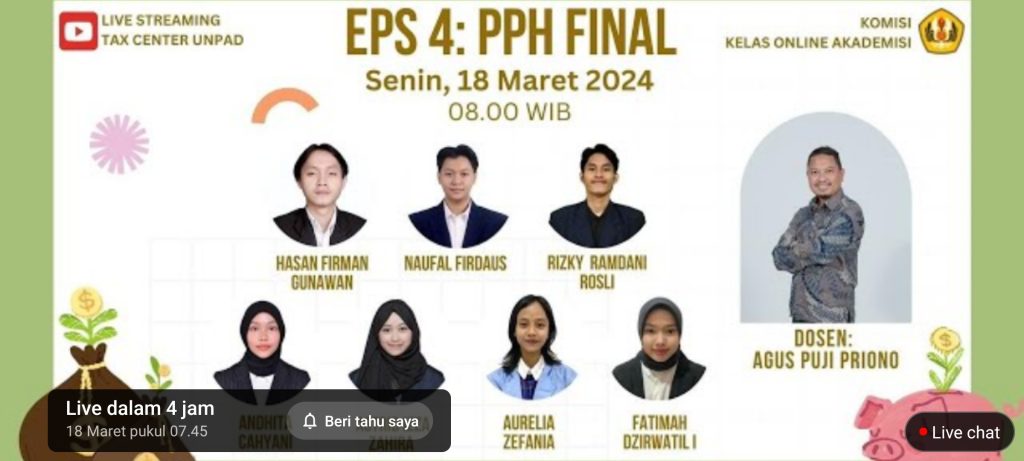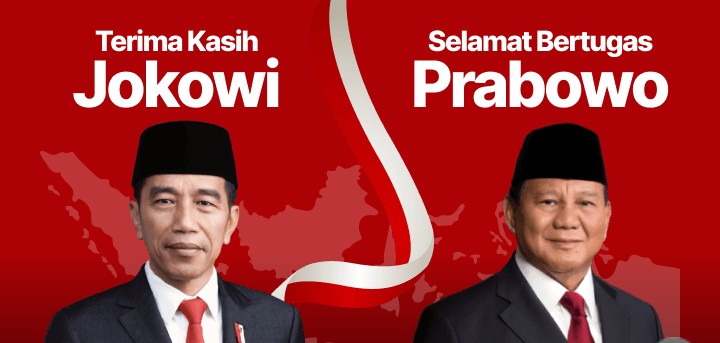
Science, Technology, Engineering, and Mathematics Collaboration Empowering Law-Enforcement (STEM CEL): A Transformative Approach to Tax Administration in Indonesia
- Ekonomi
Friday, 06 June 2025 05:24 WIB
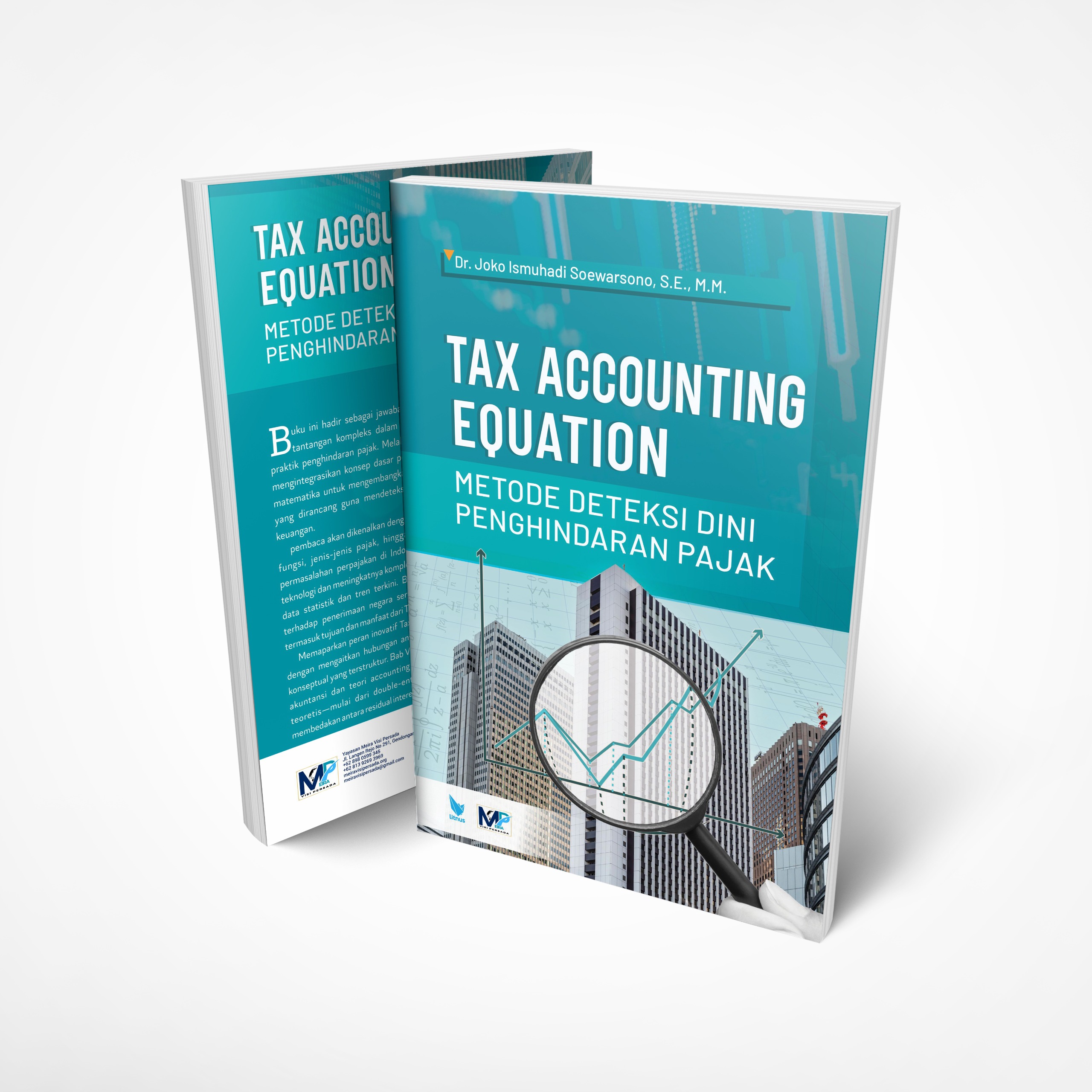
Jakarta, fiskusnews.com:
Executive Summary
The “Science, Technology, Engineering and Mathematic Collaboration Empowering Law-enforcement (STEM CEL)” initiative in Indonesia outlines a groundbreaking strategy for tax administration. This ambitious proposal seeks to integrate a “Tax Accounting Equation (TAE)” into a “Self-Assessment Monitoring System (SAMS)” within the “Core Tax Administration System (CTAS),” leveraging Triple Entry Book-keeping to identify “Underground Economy Activity (UEA).” The overarching goal is to incrementally elevate Indonesia’s tax ratio to an ambitious 23%. This initiative represents a sophisticated effort to harness advanced technology and inter-agency cooperation to bolster tax compliance, enhance operational efficiency, and expand the national tax base.
The proposed framework holds substantial promise for Indonesia. It offers the potential for significant revenue mobilization, crucial for funding public services and reducing reliance on debt. Furthermore, it aims to improve tax compliance through advanced evasion detection mechanisms and foster greater transparency in financial transactions. However, the path to implementation is fraught with considerable challenges. These include the current instability and nascent state of the CTAS, the imperative for robust data governance and privacy frameworks, a notable gap in human capital equipped with advanced analytics and forensic accounting skills, and the inherent complexities of tax reform within Indonesia’s political economy.
To navigate these challenges successfully, a strategic and phased implementation approach is critical. This involves dedicated investment in resilient digital infrastructure and cybersecurity, comprehensive capacity building for tax officials, the establishment of stringent data governance protocols, proactive engagement with stakeholders to cultivate trust, and sustained international collaboration to integrate global best practices.
1. Introduction: Indonesia’s Ambitious Tax Transformation Agenda
1.1. The Imperative for Tax Reform: Indonesia’s Tax Ratio Challenge
Indonesia faces a persistent challenge in its fiscal landscape, characterized by a low tax-to-GDP ratio. Over the past decade, this ratio has consistently hovered around 10–12%. While it saw a slight increase from 10.9% in 2021 to 12.1% in 2022, it remains marginally below the 12.2% recorded in 2007. Preliminary projections for 2024 suggest a rebound to 11.8% , yet this figure falls short of the government’s target of 11.2%-12% by 2025.
In a global context, Indonesia’s tax performance lags significantly. In 2022, its 12.1% ratio was considerably lower than the Asia and Pacific average of 19.3% and the OECD average of 34.0%. Comparisons with ASEAN neighbors further underscore this disparity, with Indonesia trailing behind Cambodia (18%), Vietnam (23%), Thailand (15%), and the Philippines (14%). The World Bank projects that Indonesia’s tax ratio will remain around 10% until 2027, highlighting its struggle to align with other middle-income and large developing economies.
The economic implications of this low tax ratio are profound. Indonesia experienced an average loss of 6.4% of its GDP in tax revenue between 2016 and 2021, primarily from value-added tax (VAT) and corporate income tax. This suboptimal revenue collection directly constrains the government’s budget, impeding its ability to fund essential public services such as infrastructure, education, and healthcare. Consequently, the government is compelled to rely more heavily on external borrowing, which escalates the national debt burden and exposes the country to global financial vulnerabilities. Moreover, insufficient revenue from progressive taxation exacerbates income inequality and social challenges, while underinvestment in critical sectors like technology and research leads to missed economic opportunities. The World Bank emphasizes that a tax-to-GDP ratio of 15% or higher is a fundamental requirement for fostering economic growth and reducing poverty.
The persistent low tax ratio stems from several underlying factors. These include the widespread application of special treatments, exemptions, and tax incentives that narrow the tax base, coupled with prevalent tax avoidance and weak enforcement mechanisms. Structural weaknesses in revenue mobilization capacity, technical loopholes, and a significant informal economy also contribute to the challenge. Crucially, a pervasive lack of taxpayer trust in how revenues are managed and redistributed, alongside perceptions of corruption and inefficiency, actively discourages compliance.
The low tax ratio in Indonesia is fundamentally rooted in a deficit of trust. This is evident in the widespread perceptions of corruption, inefficient public spending, and a general lack of confidence in government institutions. This erosion of trust directly impacts tax morale, which is a citizen’s willingness to contribute to public finances even when enforcement is weak. When citizens do not believe that their taxes are used wisely and equitably, their inclination to comply voluntarily diminishes, leading to increased tax avoidance and reduced compliance. This suggests that the trust deficit is not merely a social or political issue, but a profound structural impediment to Indonesia’s ability to mobilize revenue. Therefore, even with the introduction of advanced technological solutions like the Core Tax Administration System (CTAS), the full potential of tax collection cannot be realized without a concerted effort to address this underlying lack of trust. Achieving the ambitious target of 23% necessitates a fundamental shift in taxpayer perception and a renewed willingness to comply, which is deeply contingent on rebuilding public confidence and demonstrating fairness in the tax system.
1.2. Overview of the STEM CEL Proposal: A Vision for Modern Tax Administration
The STEM CEL proposal represents a comprehensive strategy to modernize Indonesia’s tax administration by integrating advanced scientific and technological principles with robust law enforcement capabilities. Its core vision is to establish a seamless, intelligent, and proactive tax ecosystem.
The initiative comprises several interconnected components:
- Science, Technology, Engineering and Mathematic Collaboration Empowering Law-enforcement (STEM CEL): This signifies a multi-disciplinary, inter-agency approach designed to enhance tax enforcement through data-driven insights and specialized expertise.
- Tax Accounting Equation (TAE) and Triple Entry Book-keeping: This refers to a sophisticated accounting methodology aimed at ensuring real-time, immutable, and transparent financial record-keeping.
- Self-Assessment Monitoring System (SAMS): An automated system that leverages data from the TAE to proactively monitor taxpayer compliance and identify anomalies.
- Core Tax Administration System (CTAS): This serves as the overarching digital platform, acting as the central nervous system that integrates all other components and processes.
The overarching objectives of the STEM CEL proposal are multifaceted: to significantly improve tax compliance and reduce the tax gap ; to effectively uncover and formalize Underground Economy Activity (UEA) ; to gradually increase Indonesia’s tax ratio to 23% ; and to enhance efficiency, transparency, and data integrity within tax administration. Ultimately, the initiative also aims to foster greater trust between taxpayers and the government.
The integration of SAMS, TAE (specifically Triple Entry Book-keeping), and STEM CEL signifies a fundamental shift in tax administration. SAMS, when powered by TAE, enables continuous, real-time monitoring and automated detection of anomalies in financial data. The concept of Triple Entry Book-keeping suggests a highly transparent and verifiable financial trail, potentially leveraging technologies like blockchain for immutability. Furthermore, STEM CEL’s emphasis on empowering law enforcement through advanced analytics, artificial intelligence (AI), and forensic accounting moves beyond traditional, reactive audit processes. This combination indicates a transition from a system where audits are often triggered by suspicion or random selection to one that is highly proactive and data-driven. Instead of waiting for non-compliance to be reported or discovered through post-facto audits, the system aims to identify potential issues and evasion patterns in real-time or near real-time, allowing for early detection and preventive action. This proactive stance is considered essential for addressing Indonesia’s significant tax gap and fostering improved voluntary compliance.
2. Deconstructing the STEM CEL Framework: Components and Interdependencies
The STEM CEL proposal is a complex, integrated system designed to revolutionize tax administration in Indonesia. Understanding its individual components and how they interoperate is crucial for appreciating its potential impact.
Table 2: Key Components of the STEM CEL Proposal and their Interdependencies
| Component Name | Description/Core Function | Key Technologies Involved | Primary Role in STEM CEL | Interdependencies | Relevant Snippets |
|---|---|---|---|---|---|
| CTAS | Centralized digital platform for all tax administration processes (registration, reporting, supervision). | Cloud Computing, Data Analytics, AI, Automation | Digital backbone, unifying all data and processes. | Integrates TAE, SAMS, and provides data for STEM CEL. | |
| TAE | Standardized accounting methods for tax liability determination, integrated with Triple Entry Book-keeping. | Blockchain (implied), Data Integrity tools | Ensures real-time, immutable, and verifiable financial records. | Feeds high-integrity data into CTAS and SAMS. | |
| SAMS | Automated system for continuous monitoring of taxpayer self-assessments and anomaly detection. | AI, Machine Learning, Data Analytics, Risk Scoring Algorithms | Proactive compliance monitoring, automated risk flagging. | Relies on TAE data via CTAS; flags cases for STEM CEL. | |
| STEM CEL | Multi-disciplinary collaboration empowering law enforcement with advanced analytics and forensic expertise. | Advanced Analytics, AI/ML, Forensic Accounting, Data Integration | Enhanced detection of UEA, targeted enforcement, criminal investigations. | Receives risk flags from SAMS (via CTAS); provides enforcement feedback. |
2.1. Core Tax Administration System (CTAS): The Digital Backbone
Indonesia’s Directorate General of Taxes (DGT) initiated the implementation of the Core Tax Administration System (Coretax) in early January, intending it as the country’s new tax administration system. However, its rollout has been met with numerous issues and public complaints. An economist from Universitas Gadjah Mada, Rijadh Djatu Winardi, points to a rushed implementation and insufficient preparation as primary causes for these problems.
Specific challenges encountered include:
- Technical Instability: The system has proven unprepared for mass access, leading to network bottlenecks, slow server response times, and difficulties in user access. Critical functions such as reporting, data validation, and tax automation are experiencing runtime errors and validation failures.
- Quality Assurance Deficiencies: Comprehensive quality assurance (QA) and user acceptance testing (UAT) were not conducted adequately, contributing to the functional issues.
- Commercial Off-The-Shelf (COTS) Platform Limitations: Coretax is built on a COTS platform, which offers generic solutions. However, Indonesia’s tax system possesses unique characteristics that necessitate significant customization, a factor not fully addressed in the rushed implementation.
- Data Migration Hurdles: The deployment and data migration phases did not proceed smoothly, indicating challenges in transferring historical data and integrating it into the new system.
- Inadequate User Training: Insufficient training was provided for end-users, hindering their ability to effectively navigate and utilize the new system.
Despite these significant hurdles, Coretax is recognized as a strategic initiative vital for strengthening tax administration through digitalization. It holds the potential to transform tax administration by integrating the entire administrative process—from taxpayer registration and reporting to comprehensive tax supervision. The system is designed to address Indonesia’s substantial tax gap, reduce it, enhance the overall tax ratio, and improve the quality of tax data. Within the STEM CEL proposal, CTAS is envisioned as the central platform that will unify all taxpayer data, enhance automation, and enable real-time analytics, serving as the foundational digital infrastructure for the entire initiative.
The current problems plaguing Coretax illustrate a critical challenge that can be termed the “Digital Foundation Paradox.” The more ambitious a digital transformation, such as the STEM CEL proposal which relies heavily on advanced data integration, real-time monitoring, and AI, the more critical and unforgiving the foundational infrastructure must be. The current instability and unreliability of Coretax, stemming from rushed implementation, bugs, and inherent limitations of a generic COTS platform , represent a significant accumulation of technical debt. This means that past shortcuts or insufficient investment in the foundational IT systems now impose substantial future costs and risks on ambitious new initiatives. Attempting to build complex, data-intensive systems on a shaky or ill-suited foundation will likely lead to further system failures, increased operational costs, and delays, potentially rendering the entire project unsustainable. Therefore, a significant portion of the initial investment for STEM CEL must be dedicated to thoroughly stabilizing, customizing, and stress-testing the CTAS, rather than merely adding new features. This foundational strengthening is an essential prerequisite for any successful digital transformation.
2.2. Tax Accounting Equation (TAE) and Triple Entry Book-keeping: Enhancing Financial Transparency
The Tax Accounting Equation (TAE) refers to the established methods and principles employed to determine tax liability and strategically minimize it within legal frameworks. This involves a meticulous analysis of profit and loss statements, current and future liabilities, and the specific accounting method (cash or accrual) adopted by an organization. While the research material does not explicitly detail “Triple Entry Book-keeping,” its inclusion in the query suggests an advanced accounting methodology that extends beyond traditional double-entry systems. This typically implies the addition of a third, immutable entry, often leveraging technologies like blockchain , to a public or verifiable ledger. Such a system would move beyond mere compliance-focused tax accounting to one designed for inherent transparency, real-time verification, and enhanced auditability.
The integration of TAE within a Triple Entry Book-keeping system would have profound implications for financial transparency and tax administration:
- Real-time Data Integrity: Blockchain technology, for instance, creates immutable records, significantly reducing the risk of fraud and enhancing the integrity of tax-related data. This capability could provide tax authorities with real-time, verifiable financial data, drastically improving accuracy and minimizing opportunities for manipulation.
- Enhanced Auditability: The inherent transparency and traceability offered by triple-entry systems would streamline and expedite tax audits, allowing for more comprehensive and efficient verification of transactions. Forensic accountants already utilize tax accounting methods to investigate financial statements , and this advanced system would provide a richer and more reliable data source for their work.
- Improved Compliance: With greater transparency and the ability to detect anomalies more easily, taxpayers would face stronger incentives for voluntary compliance. Such a system could identify “anomalous deductions, income inconsistencies, recurrent transaction manipulations, and irregular filing practices” , thereby promoting adherence to tax regulations.
The implementation of TAE with Triple Entry Book-keeping, with its emphasis on real-time data integrity and auditability, has a significant social implication: it fosters a “Transparency-Compliance Feedback Loop.” Indonesia’s low tax morale is closely tied to widespread perceptions of corruption, inefficient public spending, and a general lack of trust in government institutions. A system built on immutable, transparent records, potentially leveraging blockchain, inherently reduces opportunities for fraud or manipulation, not only by taxpayers but also potentially within the tax administration itself. This increased transparency can directly address the existing trust deficit. When taxpayers perceive that the system is fair, that their contributions are traceable, and that others are also complying, it can create a positive cycle where increased transparency leads to higher compliance. This, in turn, reinforces trust and can significantly improve overall tax morale. This represents a critical social benefit that extends beyond mere technical efficiency.
2.3. Self-Assessment Monitoring System (SAMS): Empowering Proactive Compliance
The Self-Assessment Monitoring System (SAMS) is envisioned as an intelligent layer within the Core Tax Administration System (CTAS), designed to leverage the real-time, verifiable data provided by the Tax Accounting Equation (TAE). Its primary function would be to continuously monitor taxpayer self-assessments against a wide array of data points, utilizing advanced analytics and potentially Artificial Intelligence (AI) and Machine Learning (ML). This system represents a departure from traditional audit selection methods, instead assigning risk scores to individual transactions and identifying “risky” or unusual patterns.
SAMS plays a crucial role in enhancing taxpayer compliance and enabling automated risk detection:
- Proactive Monitoring: SAMS would enable the Directorate General of Taxes (DGT) to proactively identify potential non-compliance or evasion. By analyzing “anomalous deductions, income inconsistencies, recurrent transaction manipulations, and irregular filing practices” , the system can flag high-risk taxpayers or transactions for further scrutiny.
- Automated Risk Detection: Globally, tax administrations are increasingly adopting AI and machine learning for risk assessment processes (69.4% of AI-using administrations) and for detecting tax evasion and fraud (75.5%). SAMS would automate a significant portion of this risk assessment, allowing for a more efficient allocation of enforcement resources.
- Fostering Voluntary Compliance: By simplifying the tax process and increasing its transparency, and by heightening the perceived likelihood of detection for non-compliance, SAMS would provide stronger incentives for voluntary compliance. The OECD’s vision for digital transformation aims to make taxation “easier and less costly for taxpayers” , and SAMS can contribute to this by reducing errors and, over time, the need for extensive auditing.
The implementation of SAMS, with its focus on automated risk detection and data-driven audits , introduces what can be conceptualized as an “Audit Efficiency Multiplier.” Traditional audits can sometimes be less cost-effective than those selected by algorithms , and there is a global trend towards assessing 100% of transactions rather than relying solely on sampling. By automating risk assessment and concentrating audit efforts on the highest-risk transactions , SAMS can significantly enhance audit efficiency. This means that the same or even fewer resources can lead to substantially higher detection rates of evasion. For example, a Tax Information System (TIS) in one instance demonstrated an 84% improvement in audit efficiency. This freed-up capacity within the DGT can then be reallocated from routine auditing to more strategic activities, such as complex fraud investigations , taxpayer education, or proactive engagement with businesses to further improve compliance, thereby optimizing the overall allocation of resources.
2.4. STEM Collaboration Empowering Law-Enforcement (STEM CEL): A Multi-Agency Approach
STEM CEL envisions a robust framework for seamless data exchange and collaborative action between tax authorities, specifically the Directorate General of Taxes (DGT), and various law enforcement agencies. This collaboration would involve integrating data from a multitude of sources, including taxpayer self-assessments, third-party records from banks and online platforms, and even customs, public procurement, and firm-to-firm transaction reports. The objective is to construct a comprehensive, 360-degree view of taxpayers , enabling more effective detection and combat of tax evasion and the underground economy. This approach aligns with global best practices that advocate for integrating tax and customs systems to enhance efficiency and facilitate data sharing.
This multi-agency approach leverages advanced analytics, AI, and forensic accounting for enforcement:
- Advanced Analytics and AI/ML: Tax administrations worldwide are increasingly utilizing data science and analytical tools (95% of tax administrations) and AI/ML (54.4%) for risk assessment and fraud detection. AI possesses the capability to uncover “previously undetectable or hidden correlations, suspicious activity, trends, indicators” , facilitating early detection and preventive action. Countries like Ecuador and Peru have successfully employed data analytics to detect tax evasion, resulting in millions of dollars in additional revenue.
- Forensic Accounting: Forensic accountants play a specialized role in investigating financial statements for government agencies. The IRS, for instance, mandates specific forensic document training for professionals to recognize fraudulent documents. The Certified in Financial Forensics (CFF) certification specifically focuses on detecting financial crimes, financial misrepresentation, and fraud prevention. STEM CEL would integrate these forensic capabilities directly into law enforcement efforts, providing the specialized expertise needed to analyze complex financial data and build compelling cases against evaders.
- Law Enforcement Tools: The IRS employs a range of enforcement tools, including collections, withholding, document matching, audits, and criminal investigations, emphasizing a combined strategy to maximize voluntary compliance. Joint enforcement strike forces, such as California’s Joint Enforcement Strike Force (JESF), coordinate efforts across tax, labor, and licensing laws to combat the underground economy effectively.
The emphasis of STEM CEL on leveraging advanced analytics, AI, and forensic accounting for law enforcement, coupled with extensive data integration across agencies, presents a “Data-Driven Enforcement Paradox.” While AI and algorithms can be highly efficient in identifying potential evasion patterns , a study in Senegal revealed that “algorithm-selected audits are less cost-effective and do not generate less corruption,” and “inspector-selected cases yield 89% higher assessments of taxes evaded on average”. This suggests that while technology can scale detection, human expertise, particularly from experienced tax inspectors and forensic accountants, remains crucial for complex investigations, evidence gathering, and ultimately, maximizing revenue from detected evasion. Over-reliance on algorithms without sufficient human oversight or the capacity to act on complex cases could lead to missed revenue opportunities and potentially foster perceptions of unfairness if algorithms exhibit bias. The implication is that STEM CEL must not solely focus on implementing technology but also strategically enhance human capabilities in forensic accounting and complex audit management. This ensures a symbiotic relationship where AI augments human intelligence, rather than replacing it entirely. The DGT’s existing emphasis on “persuasive methods” before resorting to enforcement further underscores the need to balance aggressive data-driven enforcement with strategies that encourage voluntary compliance and maintain public trust.
3. Uncovering the Underground Economy Activity (UEA): A Key Objective
3.1. Understanding the Informal Sector and UEA in Indonesia
The informal economy, often referred to as the underground economy (UEA) or shadow economy, encompasses unreported economic activities where no invoices or fiscal receipts are issued, resulting in unpaid taxes. This sector poses a significant challenge, particularly in low- and middle-income countries , where it is estimated to average 33% of GDP in developing economies. Indonesia’s struggle with a substantial informal sector is a primary contributor to its persistently low tax ratio. Informal firms typically do not contribute to the formal tax base, tend to remain small, exhibit low productivity, and have limited access to formal finance. This considerable portion of economic activity operating outside regulation represents a significant unrealized tax revenue potential, directly contributing to Indonesia’s high tax gap. Prominent Indonesian figures, such as Hashim Djojohadikusumo, have explicitly highlighted the urgent need to enhance tax collection from this shadow economy.
Measuring the informal economy remains a stubbornly elusive task, primarily because those engaged in tax evasion actively seek to avoid detection. Traditional direct methods, such as surveys and fiscal audits, suffer from inherent disadvantages; individuals may be reluctant to admit fraudulent behavior, and audits are often not representative of the entire population. Indirect methods, which rely on macroeconomic indicators like discrepancies between national incomes and expenses or official versus actual labor force participation, are often crude, unreliable, and can reflect other errors within national accounts rather than solely informal activity. More sophisticated approaches, such as Multiple Indicators Multiple Causes (MIMIC) models, utilize causal and indicator variables to estimate the unobserved shadow economy. Recent research has explored using discrepancies between collected VAT and consumption survey data to estimate underpayment and the size of the informal economy, an approach that is more algorithmic and adaptable over time.
The presence of a large informal sector in Indonesia creates what can be described as an “Informality-Fiscal Capacity Trap.” This phenomenon occurs because the government, constrained by low tax revenue, lacks the necessary fiscal capacity to invest adequately in crucial public goods such as infrastructure, education, and healthcare. These investments are vital for boosting overall productivity and fostering the growth of the formal sector. Simultaneously, informal businesses, by operating outside tax and regulatory frameworks, remain less productive and are unable to access formal benefits like credit, which could otherwise facilitate their growth and formalization. This perpetuates a vicious cycle: low fiscal capacity hinders efforts to formalize the economy, while persistent informality continues to limit the government’s fiscal capacity. Therefore, simply attempting to tax the informal sector in isolation is insufficient. A holistic approach is required that simultaneously reduces the costs associated with formalization (e.g., through simplified tax procedures ), increases the benefits of formality (e.g., improved access to credit ), and leverages digital platforms to make registration and compliance easier. Such a comprehensive strategy is essential for achieving sustainable formalization and breaking free from this trap.
3.2. Technology-Driven Strategies for UEA Detection and Formalization
Combating the underground economy and driving formalization necessitates a multi-pronged, technology-driven approach.
Data Analytics, AI/ML, and Digital Payment Integration:
- Advanced Data Analytics and AI/ML: These technologies are critical for detecting complex tax evasion patterns. AI and Machine Learning can identify anomalies, outliers, and reduce data dimensionality, revealing “anomalous deductions, income inconsistencies, recurrent transaction manipulations, and irregular filing practices”. Globally, tax administrations are extensively utilizing AI for risk assessment (69.4%) and fraud detection (75.5%). Countries like Ecuador and Peru have demonstrated success in using data analytics to detect tax evasion, leading to millions of dollars in additional revenue.
- Digital Payment Integration: Leveraging digital payment platforms, such as Rwanda’s eKash, can significantly lower barriers to digital financial inclusion and generate extensive transactional datasets that were previously obscured. This digital adoption can boost formal access to financial services (Rwanda saw an increase from 77% to 92% in just four years) and provide comprehensive insights into economic activities. Digital tax collection technology can also enable governments to collect taxes from the informal economic sector by tracking digital transactions.
- E-invoicing and Electronic Fiscal Devices: Mandatory electronic invoicing and electronic fiscal devices that record and transmit sales data electronically are powerful tools for real-time monitoring of commercial transactions. They enhance transparency and actively prevent tax fraud. Saudi Arabia’s implementation of a “National E-invoicing FATOORA Program” serves as a notable example.
Formalization Strategies: Effective approaches to increase formalization involve reducing the ongoing costs of operating formally (e.g., through simplified tax procedures and lower initial tax rates) and enhancing the benefits of formality (e.g., improved access to credit). Simultaneously, increased enforcement through inspections can act as a deterrent to informality. Education and outreach programs, such as India’s “One-Stop-Shop” model, simplify registration processes and encourage compliance. Furthermore, digital platforms dramatically reduce the cost of registration and compliance, as evidenced by successful implementations in South Korea and Estonia.
3.3. The Role of STEM CEL in Strengthening UEA Combat Efforts
The strength of STEM CEL lies in its integrated approach, which combines advanced data analytics, AI, and forensic accounting with robust law enforcement capabilities. This synergy allows for a more systematic and comprehensive attack on the underground economy.
Enhanced Detection: By integrating data from various sources—including taxpayer declarations, third-party data, digital payment platforms, customs records, public procurement data, and firm-to-firm transactions —STEM CEL can construct a more complete and accurate picture of economic activity. This makes it significantly more challenging for UEA to remain hidden. AI’s capacity to detect subtle patterns and correlations that might escape human observation will be particularly crucial in this regard.
Targeted Enforcement: The application of risk-scoring algorithms and data-driven audit selection methodologies will enable more targeted and efficient enforcement actions. Resources can be focused on the highest-risk areas and individuals, thereby enhancing the overall effectiveness of tax law enforcement.
Cross-Agency Cooperation: The “collaboration empowering law-enforcement” aspect inherent in STEM CEL directly facilitates joint enforcement efforts. This mirrors initiatives like California’s Joint Enforcement Strike Force , which allows for a coordinated response to violations spanning tax, labor, and licensing laws.
The widespread adoption and integration of digital technologies, facilitated by the STEM CEL initiative, will lead to a significant expansion of the “Digital Footprint” for economic activities that were previously informal or untraceable. The underground economy thrives on unreported economic activity and cash-based transactions. However, the integration of digital payment systems , e-invoicing , and electronic fiscal devices generates extensive and detailed transactional datasets and enables real-time monitoring of commercial transactions. This directly addresses the challenges of identification and registration avoidance and limited enforcement capacity by making transactions visible and traceable. The implication is that STEM CEL is not merely about detecting existing UEA, but actively formalizing segments of the informal economy by creating a digital trail that encourages registration and compliance. This, in turn, broadens Indonesia’s tax base and significantly increases its revenue potential.
4. Pathways to a 23% Tax Ratio: Economic and Social Implications
4.1. Economic and Social Benefits of a Higher Tax Ratio
Achieving a higher tax ratio in Indonesia would yield substantial economic and social benefits, contributing to the nation’s long-term prosperity and stability.
Funding Public Services and Development: A direct consequence of an increased tax ratio is a surge in government revenue. This additional funding can be strategically invested in critical public services and development projects, including infrastructure, education, and healthcare. Such investments are fundamental drivers of long-term economic growth and play a crucial role in poverty reduction.
Fiscal Sustainability and Reduced Debt Reliance: A robust tax ratio is a cornerstone of fiscal sustainability. It provides governments with sufficient domestic resources to fund long-term development initiatives without excessive reliance on external borrowing. This reduces the national debt burden and mitigates exposure to global financial risks, enhancing overall economic resilience.
Reducing Inequality and Enhancing Social Equity: A higher tax ratio, particularly when coupled with progressive taxation systems, can effectively promote fairness by enabling the redistribution of wealth and reducing income inequality. For example, a progressive Value Added Tax (VAT) system that incorporates real-time compensation mechanisms for low-income households can significantly mitigate the regressive impact of consumption taxes. This ensures that increased revenue collection does not disproportionately burden the most vulnerable segments of society.
Economic Stability and Growth: A consistent or rising tax ratio is indicative of healthy economic growth and increased purchasing power within the economy. It provides a vital buffer against economic shocks and external uncertainties, contributing to overall economic stability. When higher tax revenues are strategically reinvested in productive public initiatives—such as green infrastructure, education, or research—they can lead to a net positive effect on GDP in the long run.
4.2. Feasibility and Strategies for Achieving 23%
Indonesia’s aspiration to achieve a 23% tax ratio is ambitious, aiming to reach the current levels observed in countries like Vietnam. This target represents a significant leap from its current range of 10-12% and surpasses the World Bank’s recommended 15% threshold for sustainable development. Achieving this goal will require a multi-faceted approach, drawing lessons from international experiences and implementing strategic reforms.
Lessons from Successful Countries:
- Rwanda: Demonstrated remarkable success by implementing digital systems, including point-of-sale (POS) devices and e-tax filing. These initiatives contributed to a 4.5 percentage point increase in its tax-to-GDP ratio, rising from 12.1% in 2004 to 16.6% by 2016. Concurrently, Rwanda saw a significant improvement in its World Bank ease of doing business ranking.
- South Africa: Adopted an e-filing system that enhanced tax payment captures and management. This led to a notable increase in tax returns filed within 48 hours, from 1.6% in 2007 to 34% in 2008.
- Tunisia: Implemented an online filing and payment system that saw its tax collection increase from 12.3% of GDP in 2007 to 19% in 2008.
- Scandinavian Countries (Denmark, Norway, Sweden): These nations consistently achieve high tax-to-GDP ratios (ranging from 42-47%). Their success is attributed to leveraging broad-based taxes, particularly high consumption taxes (VAT at 25%) and substantial social security contributions. Top income tax rates in these countries often apply to upper-middle-class earners. Corporate income taxes play a less significant role in their revenue generation, with the exception of Norway’s extractive industries.
- Recent OECD Increases (Luxembourg, Colombia, Türkiye): In 2023, Luxembourg increased its ratio by 2.7 percentage points, driven by personal income tax (PIT) and social security contributions (SSC). Colombia saw a 2.6 percentage point increase primarily from corporate income tax (CIT). Türkiye’s ratio rose by 2.5 percentage points due to increases in taxes on goods and services and social security contributions.
- TaxDev Initiative (Ethiopia, Ghana, Uganda, Rwanda): This initiative focused on improving tax policymaking through partnerships, increasing data resources, building technical skills, and utilizing evidence to inform policy decisions.
Key Strategies for Indonesia:
- Tax Base Expansion: Formalizing the informal sector is paramount. This involves incentivizing small businesses to register and comply with tax regulations, and actively targeting high-income earners and freelancers through enhanced data integration and reporting.
- Policy Reforms: Implementing simplified tax procedures and offering strategic incentives are crucial. Rationalizing tax expenditures—which include exemptions, deductions, and reduced rates—can recover substantial forgone revenue, estimated at an average of 2.5% of GDP for low- and middle-income countries. Tax system design must be carefully crafted to avoid inadvertently increasing incentives for informality.
- Addressing Tax Morale: Cultivating public trust through transparency in tax collection and allocation, and clearly demonstrating the tangible benefits derived from tax revenues, is critical for fostering increased voluntary compliance.
Achieving a 23% tax ratio is an ambitious undertaking that goes beyond mere technical adjustments. Simply raising existing tax rates across the board could have adverse economic effects. Different types of taxes have varying impacts on GDP; for instance, increases in income tax tend to have the least negative effect, while corporate taxes are considered the “worst” for growth, and VAT also impacts consumption. Successful countries, like those in Scandinavia, rely heavily on broad-based consumption and labor taxes. This highlights the need for a sophisticated “Policy Mix Imperative.” Indonesia’s strategy must involve carefully selecting which taxes to increase (e.g., focusing on personal income tax and consumption taxes with progressive elements ) while simultaneously minimizing disincentives for investment, particularly regarding corporate tax. This approach requires balancing revenue generation with broader economic growth objectives and social equity considerations. Furthermore, the success stories of Rwanda, South Africa, and Tunisia demonstrate that technological reforms are often implemented in conjunction with broader tax policy changes. This implies that the STEM CEL initiative must be an integral part of a larger, well-calibrated fiscal policy reform package, rather than a standalone solution, to ensure sustainable and equitable tax ratio growth.
Table 5: Case Studies of Countries Successfully Increasing Tax-to-GDP Ratio
| Country | Period of Increase | Tax-to-GDP Ratio Change | Key Strategies/Tax Types Contributing | Relevant Snippets |
|---|---|---|---|---|
| Rwanda | 2004-2016 | +4.5 p.p. (12.1% to 16.6%) | Digital systems (POS, e-tax filing) | |
| South Africa | 2007-2008 | Significant increase in e-filed returns | E-filing system | |
| Tunisia | 2007-2008 | +6.7 p.p. (12.3% to 19%) | Online filing and payment system | |
| Luxembourg | 2022-2023 | +2.7 p.p. | Personal Income Tax (PIT), Social Security Contributions (SSC) | |
| Colombia | 2022-2023 | +2.6 p.p. | Corporate Income Tax (CIT) | |
| Türkiye | 2022-2023 | +2.5 p.p. | Taxes on goods and services, Social Security Contributions (SSC) |
4.3. Balancing Revenue Mobilization with Social Equity
Indonesia’s Value Added Tax (VAT) system faces the inherent challenge of balancing the critical need for increased government revenue with the imperative of ensuring social equity. VAT, by its nature, tends to be regressive, disproportionately burdening lower-income households who allocate a larger share of their income to consumption. The Indonesian government has already demonstrated a prudent approach by maintaining an effective VAT rate of 11% despite a formal 12% rate, specifically to safeguard public purchasing power and control inflation. For luxury goods, a higher effective VAT rate of 12% has been applied, reflecting an equitable fiscal policy that generates additional revenue without significantly disrupting the sector.
Proposed Solution: Real-time Digital Compensation: A progressive VAT system, characterized by a single rate coupled with real-time digital compensation for low-income households, presents a viable solution to this dilemma. This mechanism would mitigate the regressive impact of VAT by providing direct reimbursements to eligible individuals, leveraging Indonesia’s existing digital payment platforms and the Core Tax Administration System (CTAS). Merging citizen and taxpayer identification systems is a crucial step for accurately identifying eligible recipients and ensuring the efficient delivery of compensation.
Challenges in Implementation: Implementing such a progressive VAT system is not without its challenges. These include addressing barriers to access in rural areas where digital infrastructure may be limited, ensuring equitable access to the compensation mechanism. Furthermore, overcoming political obstacles stemming from entrenched interests and the popularity of existing tax exemptions will be a significant hurdle. Maintaining transparency in data collection and utilization is also paramount to sustaining public trust throughout the reform process.
The discussion around tax increases, particularly indirect taxes like VAT, highlights the classic “equity-efficiency trade-off” in tax policy. Broad-based taxes are generally efficient for revenue generation but can be inequitable due to their regressive nature, disproportionately burdening lower-income households. Indonesia’s government is acutely aware of public concerns regarding VAT increases and strives to balance revenue needs with price stability and public purchasing power. The proposed solution, a progressive VAT with real-time digital compensation for low-income households, leverages the capabilities of CTAS and existing digital payment infrastructure. This represents a technological solution to a traditional policy dilemma. It allows for the efficiency of a uniform VAT rate while simultaneously addressing equity concerns through targeted, real-time compensation. This digital solution transforms a complex policy challenge into a more manageable technical and administrative one, potentially making a higher tax ratio more socially palatable and politically feasible, provided the underlying digital infrastructure and data integration are robust and transparent.
5. Critical Challenges and Considerations for Implementation
5.1. Technological Hurdles and Infrastructure Requirements
The successful implementation of the STEM CEL proposal hinges on robust and reliable technological infrastructure, an area where Indonesia currently faces significant challenges.
CTAS Stability and Scalability: The Core Tax Administration System (Coretax), intended as the foundation, is currently grappling with substantial issues. It is reportedly unprepared for mass access, experiencing network bottlenecks, slow server response times, and bugs in critical functions. Furthermore, its reliance on a Commercial Off-The-Shelf (COTS) platform necessitates extensive customization to align with Indonesia’s unique tax system. These foundational instabilities pose a major risk to integrating complex new components like the Tax Accounting Equation (TAE) and Self-Assessment Monitoring System (SAMS), both of which demand a highly robust and scalable infrastructure.
The current problems with Coretax are indicative of what can be termed “technical debt accumulation.” This refers to the implicit cost of additional rework caused by choosing an easy solution now instead of using a better approach that would take longer. In this context, past shortcuts or insufficient investment in foundational IT systems now impose significant future costs and risks on ambitious new initiatives like STEM CEL. The IMF highlights that “outdated systems, limited interoperability, and difficulties to establish governance frameworks” hinder digital transformation in developing economies. Attempting to build complex AI-driven, data-intensive systems on a shaky or ill-suited foundation will likely lead to further system failures, increased operational costs, and delays, potentially making the entire project unsustainable. This means a substantial portion of the initial investment for STEM CEL must be dedicated to thoroughly stabilizing, customizing, and stress-testing the CTAS, rather than merely adding new features. This foundational strengthening is a critical prerequisite for any successful digital transformation.
Data Migration and Integration: Smooth and accurate data migration from legacy systems to the new digital platform is critical, yet it has been a problematic aspect of Coretax’s rollout. The STEM CEL proposal demands seamless integration of diverse data sources from various government entities (e.g., social security, customs, law enforcement) and third parties (e.g., banks, online platforms). This necessitates rigorous data standardization, the development of unified platforms, and the establishment of robust interoperability frameworks to ensure cohesive data flow and analysis.
Cybersecurity: Advanced tax administration systems handle vast amounts of highly sensitive taxpayer information, making robust cybersecurity measures paramount. Key security protocols include comprehensive encryption of all transmitted and stored data, stringent access control mechanisms, detailed audit trails, and regular compliance audits. The Finnish Tax Administration, for instance, successfully transitioned to secure cloud-based solutions to process confidential data for 5.5 million citizens and mitigate escalating cyber threats. A significant data breach could severely erode public trust, undermining the entire initiative.
Cloud Computing Challenges: While cloud computing offers scalable infrastructure essential for handling large datasets and powering AI initiatives , its tax implications are complex and vary significantly by jurisdiction. Proper mapping of cloud service usage, meticulous review of provider agreements, and diligent documentation of allocation methods are crucial for effective tax planning and compliance in a multi-jurisdictional environment.
5.2. Human Capital Development and Organizational Readiness
The successful implementation of STEM CEL requires a significant transformation in human capital and organizational culture within Indonesia’s tax administration.
Skill Gap in Advanced Analytics and AI: The DGT currently faces a notable skill gap in advanced analytics, data science, and AI. While tax administrations globally are increasingly using data science and analytical tools (95% of TAs) and AI/ML (54.4%) for risk assessment and fraud detection , Indonesia’s DGT needs to rapidly develop these capabilities. The shift towards data-driven decision-making requires training tax officials in complex scenarios involving diverse data sources and the use of machine learning and AI tools for fraud detection, revenue forecasting, and compliance monitoring. The IRS, for example, is adopting a use-case-driven strategy for AI, focusing on enhancing taxpayer interactions and improving compliance monitoring.
Forensic Accounting Expertise: The integration of forensic accounting into law enforcement efforts is critical for investigating complex financial crimes and building strong cases against evaders. This requires specialized training in detecting financial misrepresentation, fraud prevention, and analyzing financial information. The IRS mandates formal forensic document training for certain professionals to recognize fraudulent documents, such as passports and identification cards. Developing a cadre of Certified in Financial Forensics (CFF) professionals within the DGT and law enforcement agencies will be essential.
Change Management and Data-Driven Culture: Implementing such a transformative initiative necessitates a comprehensive change management program across the entire tax administration. Administrative staff require proper training in new skills, abilities, and competencies related to the new operational blueprint and tax technologies. Fostering a data-driven culture means moving beyond gut feelings to decisions grounded in data-derived insights, requiring improved data literacy and democratized data access for all employees. This cultural shift is crucial for ensuring that employees are comfortable using technology as a tool to support their daily operations and leverage new insights effectively.
The implementation of AI in tax administrations presents a significant challenge regarding the “Human-AI Symbiosis Imperative.” While AI can enhance efficiency and detect patterns, the role of human officials in decision-making shifts. When AI systems operate without human intervention, the decision-making authority moves from the human to the AI system, which bases decisions on its interpretation of data. Even when human review is required, explaining “black box” AI decisions can introduce uncertainty. This indicates that the success of STEM CEL is not merely about deploying technology but about cultivating a symbiotic relationship between human expertise and AI capabilities. The DGT must strategically invest in training its workforce to understand, interpret, and effectively utilize AI-generated insights, rather than simply relying on automated outputs. This includes developing new skills in data analytics, data mining, and forensic auditing. The aim is to ensure that human officials can provide informed oversight, conduct complex investigations that algorithms might miss, and maintain the necessary human judgment for sensitive cases, thereby maximizing the benefits of AI while mitigating its risks and ensuring accountability.
5.3. Data Governance, Privacy, and Ethical Considerations
The extensive data collection and sharing envisioned by STEM CEL raise critical concerns regarding data governance, privacy, and ethical use.
Data Quality and Integrity: The effectiveness of any data-driven system, including STEM CEL, hinges on the quality and integrity of the underlying data. Government agencies accumulate vast amounts of data, much of which is self-reported and prone to errors, omissions, and inconsistencies. The use of multiple disparate systems further exacerbates issues like data duplication and conflicts. Ensuring data cleansing, enrichment, and the establishment of a “golden record” for each individual or entity is paramount. The US Department of the Treasury emphasizes the importance of objective, useful, correct, and high-quality information, particularly when it impacts financial decisions.
Privacy and Data Protection: Handling sensitive taxpayer information requires stringent adherence to data privacy legislation, such as GDPR and other local data protection laws. Key security measures include encryption, robust access control, and automated audit trails. The Privacy Act of 1974 in the US, for instance, establishes “fair information practices” for federal agencies, requiring accuracy, relevance, timeliness, and completeness of records to ensure fairness to individuals. Any data sharing agreements, particularly those involving sensitive taxpayer information with law enforcement agencies, raise significant legal and practical concerns regarding the scope of data, accuracy of requests, and post-disclosure privacy compliance. Improper data sharing can severely erode taxpayer trust and even lead to criminal and civil liabilities for officials.
Privacy-Enhancing Technologies (PETs): To navigate the tension between data utility and privacy protection, the adoption of Privacy-Enhancing Technologies (PETs) is crucial. PETs enable the collection, analysis, and sharing of information while safeguarding data confidentiality and privacy. They are not a standalone solution but complement existing privacy frameworks. PETs can help operationalize “privacy by design and default” within AI systems, allowing organizations to access and use data that would otherwise be unavailable. Examples include synthetic data generation, homomorphic encryption, differential privacy, federated learning, trusted execution environments, and secure multi-party computation. Regulatory bodies are encouraged to provide clearer guidance and incentivize the adoption of PETs to foster trust and enable responsible data use.
Ethical AI and Algorithmic Bias: The intensive use of data and algorithms, particularly AI for tax inspection functions, poses significant ethical challenges, including the potential for algorithmic bias. If predictive models are not designed with ethical and transparent criteria, they may generate biases, leading to unfair outcomes for taxpayers. It is essential for tax administrations to implement mechanisms such as algorithmic auditing and ensure fairness in the use of technology to protect taxpayers’ rights. Regulatory bodies are anticipated to introduce frameworks for the ethical use of AI in tax administration as digital transformation becomes more widespread.
The extensive data collection and sharing inherent in STEM CEL highlight a critical challenge: the “Privacy-Utility Nexus.” This refers to the inherent tension between maximizing the utility of data for effective tax administration and ensuring the robust protection of individual privacy. While STEM CEL aims to leverage vast datasets for enhanced detection and enforcement, the very act of collecting and integrating sensitive taxpayer information creates significant privacy risks. The use of AI, in particular, raises concerns about algorithmic bias and the potential for unfair or opaque decision-making. This means that simply acquiring and processing more data is insufficient; the DGT must invest heavily in Privacy-Enhancing Technologies (PETs) to enable data use while simultaneously safeguarding confidentiality. Furthermore, robust data governance frameworks, clear communication about data usage, and mechanisms for accountability are essential to build and maintain taxpayer trust, which is fundamental for voluntary compliance. Without addressing this nexus effectively, the perceived benefits of data utility could be severely undermined by a loss of public confidence and potential legal repercussions.
5.4. Political Economy and Public Trust
The success of the STEM CEL proposal is not solely a technical or administrative endeavor; it is deeply intertwined with Indonesia’s political economy and the crucial element of public trust.
Low Tax Morale and Trust Deficit: Indonesia’s persistently low tax morale is deeply rooted in its historical, political, and cultural fabric. Widespread perceptions of corruption, inefficient public spending, and a lack of trust in government institutions significantly deter voluntary compliance. The logic of reciprocity becomes distorted when citizens perceive the state as unaccountable. Tax morale cannot be legislated into existence; it must be earned through transparent governance, equitable enforcement, and wise public spending.
Stakeholder Engagement and Communication: Successful digital public finance reforms require broad stakeholder engagement, including citizens, technologists, and regulators. Clear and consistent communication is paramount for building trust and transparency in tax collection. This includes providing understandable instructions, promptly communicating changes in tax laws, and offering accessible support channels. The DGT has shown commitment to taxpayer-centric services, digital platforms, and tax education programs (Pajak Bertutur) to shape tax morale culturally.
Political Will and Overcoming Resistance: Implementing a broad-based tax system, especially one that eliminates exemptions and special rates, requires overcoming entrenched interests and established practices. Political resistance from influential groups, such as affluent landowners in the case of property tax reforms, can significantly hamper the adoption of necessary policy changes. The presence of “veto players” in the political system can lead to policy gridlock, making it challenging to enact new tax policies or reform existing ones. Indonesia’s Finance Minister Sri Mulyani previously revised a proposed VAT rate increase in response to public concerns and protests.
Formalizing the Informal Sector: While technology can assist, formalizing the large informal sector involves complex social and economic considerations. Effective approaches include reducing the costs and increasing the benefits of formality, alongside targeted enforcement. However, social protection programs can sometimes inadvertently create incentives for workers to remain informal. Policies must recognize the heterogeneity of informal actors and address multiple dimensions of informality.
The challenges related to political economy and public trust in Indonesia reflect a “Political Will-Implementation Gap.” While there is a clear imperative to increase the tax ratio and combat the underground economy , the political will to enact and sustain potentially unpopular reforms is often constrained by public concerns, entrenched interests, and the complexities of a multi-stakeholder environment. The persistent low tax morale, rooted in perceptions of corruption and inefficient spending , means that even technically sound policies may face resistance if not accompanied by significant efforts to rebuild trust and demonstrate tangible benefits of taxation. The STEM CEL proposal’s success is therefore not merely about its technical sophistication but its ability to navigate this political landscape. This requires strong, consistent political leadership, a commitment to transparency and accountability in tax administration, and a strategic communication plan that educates citizens on the benefits of compliance and the effective use of tax revenues. Without effectively bridging this gap, the ambitious targets of STEM CEL may remain elusive, regardless of technological advancements.
6. Conclusions and Recommendations
The STEM CEL proposal represents a sophisticated and potentially transformative approach to modernizing tax administration in Indonesia, with the ambitious goal of significantly increasing the tax ratio to 23% by uncovering underground economic activity. The integration of a robust Core Tax Administration System (CTAS), a transparent Tax Accounting Equation (TAE) with Triple Entry Book-keeping, a proactive Self-Assessment Monitoring System (SAMS), and a collaborative STEM-empowered law enforcement framework offers a pathway to enhanced efficiency, data integrity, and compliance. The initiative’s potential to formalize the informal economy through digital footprint expansion and to leverage advanced analytics, AI, and forensic accounting for targeted enforcement is substantial. A higher tax ratio would provide critical funding for public services, improve fiscal sustainability, and contribute to reducing inequality and fostering economic growth.
However, the realization of this vision is contingent upon addressing significant challenges. The current instability and immaturity of the CTAS pose a foundational risk, highlighting the need to resolve technical debt before layering on complex new systems. The extensive data collection and sharing necessitate stringent data governance, privacy-enhancing technologies, and ethical guidelines to build and maintain taxpayer trust. A substantial human capital gap in advanced analytics and forensic accounting requires comprehensive capacity building and a cultural shift towards data-driven decision-making. Furthermore, navigating the complex political economy of tax reform, overcoming resistance from entrenched interests, and rebuilding public trust are paramount.
Based on this analysis, the following recommendations are put forth to guide the successful implementation of the STEM CEL initiative:
- Prioritize CTAS Stabilization and Customization: Before proceeding with full integration of TAE and SAMS, a dedicated and substantial investment must be made to stabilize, debug, and customize the Core Tax Administration System (Coretax) to meet Indonesia’s unique tax system requirements. This includes comprehensive quality assurance, user acceptance testing, and a phased rollout strategy, potentially running parallel with legacy systems, to ensure a robust and scalable digital foundation.
- Develop a Holistic Data Governance and Privacy Framework: Establish a comprehensive framework for data quality, integrity, and security across all integrated systems. Implement Privacy-Enhancing Technologies (PETs) to enable secure data sharing and analysis while safeguarding taxpayer privacy. Develop clear guidelines for the ethical use of AI, including mechanisms for algorithmic auditing and addressing potential biases, to ensure fairness and accountability.
- Invest in Strategic Human Capital Development: Implement targeted training programs to bridge the skill gap in advanced analytics, data science, AI, and forensic accounting within the Directorate General of Taxes and collaborating law enforcement agencies. Foster a data-driven culture through continuous training, democratized data access, and leadership support, ensuring a symbiotic relationship between human expertise and technological capabilities.
- Cultivate Public Trust and Stakeholder Engagement: Launch proactive and transparent communication campaigns to educate citizens and businesses about the benefits of tax compliance and the tangible impact of tax revenues on public services. Engage all key stakeholders—including taxpayers, businesses, and civil society—in the reform process to foster collaboration, address concerns, and build consensus, thereby enhancing tax morale and voluntary compliance.
- Implement a Calibrated Fiscal Policy Mix: Recognize that achieving a 23% tax ratio requires not just technological solutions but also a strategic recalibration of tax policies. Carefully consider the economic impacts of different tax types, prioritizing those that minimize disincentives for growth while maximizing revenue. Explore progressive tax mechanisms, such as real-time digital compensation for VAT, to balance revenue mobilization with social equity and ensure that the increased tax burden is distributed fairly.
- Leverage International Collaboration and Best Practices: Actively seek partnerships with international organizations (e.g., OECD, IMF, World Bank) and learn from countries that have successfully increased their tax-to-GDP ratios through digital transformation and comprehensive tax reforms. This includes sharing experiences, adopting proven methodologies, and collaborating on research and development in tax technology and administration.
By systematically addressing these critical challenges and implementing these strategic recommendations, Indonesia can significantly enhance the likelihood of success for its ambitious STEM CEL initiative, paving the way for a more efficient, equitable, and fiscally robust future.
Reporter: Marshanda Gita – Pertapsi Muda
Share
Berita Lainnya
The Tax Accounting Equation: A Forensic Tool for Detecting Underground Economic Activity and Tax Evasion
🎯 USKP A REVIEW Batch I 2025 – PKM Institute
Kajian Ramadhan dengan Tema: “Bersih- bersih sepanjang Ramadhan”
Analysis of Financial Strategies for Taxable Income Reduction in Indonesia
RAMADHAN HARI KE-12
SOLUSI PERPAJAKAN TERKINI DALAM ERA DIGITAL DAN TRANSPARANSI GLOBAL
Rekomendasi untuk Anda

Berita Terbaru
Eksplor lebih dalam berita dan program khas fiskusnews.com
Tag Terpopuler
# #TAE
# #TAX ACCOUNTING EQUATION
# #TAX FRAUD
# #TAX EVASION


